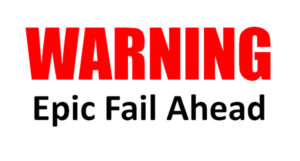
One of my personal branding clients is looking for a new position as a mid-level manager in a corporate environment. We redid her resume and LinkedIn profile, and I’ve been coaching her on how to reach the right hiring managers. She’s still a bit old school and prefers to use corporations’ ATS (applicant tracking system) programs to upload her resume for job listings. She now understands why I (and many other job coaches) advise people to avoid those systems at all costs.
This morning she called me, baffled and annoyed. She’d been trying to apply for a job on a company’s site and the ATS setup was confusing her. I set up a video share and took a look.
The first page had the standard “Please enter your contact information” fields, including one for whether or not you were a current employee. If yes, please enter your employee number. She entered her contact info and clicked “no”—she wasn’t a current employee. Then she clicked “Save and continue.”
ERROR! YOU MUST ENTER YOUR EMPLOYEE NUMBER!
There was no way past that first page without an employee number. We finally added a few zeros to the field and it sent us to the next page.
Now came the section where you upload your resume and it fills in the various job fields. As usual, this did not go smoothly (missing some employers, dates mislabeled, etc.), and my client had to manually correct most of the fields. Then she clicked “Save and continue.”
ERROR! THE VALUE YOU HAVE ENTERED IN THE FIELD “EMPLOYER” IS NOT VALID. PLEASE CLICK “SELECT” AND SPECIFY THE APPROPRIATE VALUE.
It took a bit of digging, but it turns out that she had to choose from a list of existing companies rather than accepting the automatic information from her resume. However, her current employer wasn’t on the list (of 20,000 worldwide organizations). She couldn’t move forward.
I told her she could mail her resume and cover letter directly to the organization. But, I cautioned, did she really want to? Did she really want to be part of a company that presented itself so badly? And worst of all, the company was a multi-national corporation marketing itself as having the world’s best digital technology consultants!
She’s thinking about it. She’d be a perfect fit to the job description and, knowing her drive and abilities, would be a real asset to the company. But there is a very good chance that just she’ll walk away.
So it’s worth considering: How well—or badly—is your ATS designed? Are your questions necessary or intrusive? Is your ATS actually repelling candidates instead of making the application process more efficient? Finally, ask yourself this: Would you ever, in a million years, ask potential customers to jump through the same hoops you expect potential employees to?
A system overhaul is never easy, but it’s something to think about the next time you hear someone in your organization bemoaning the lack of acceptable job candidates.
They are out there. You just may have pushed them away.
